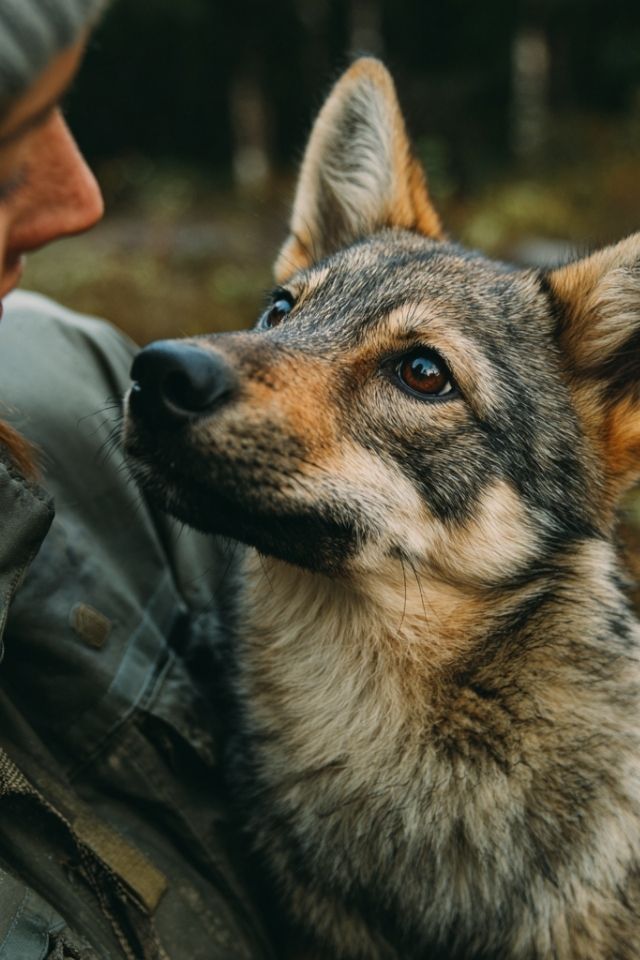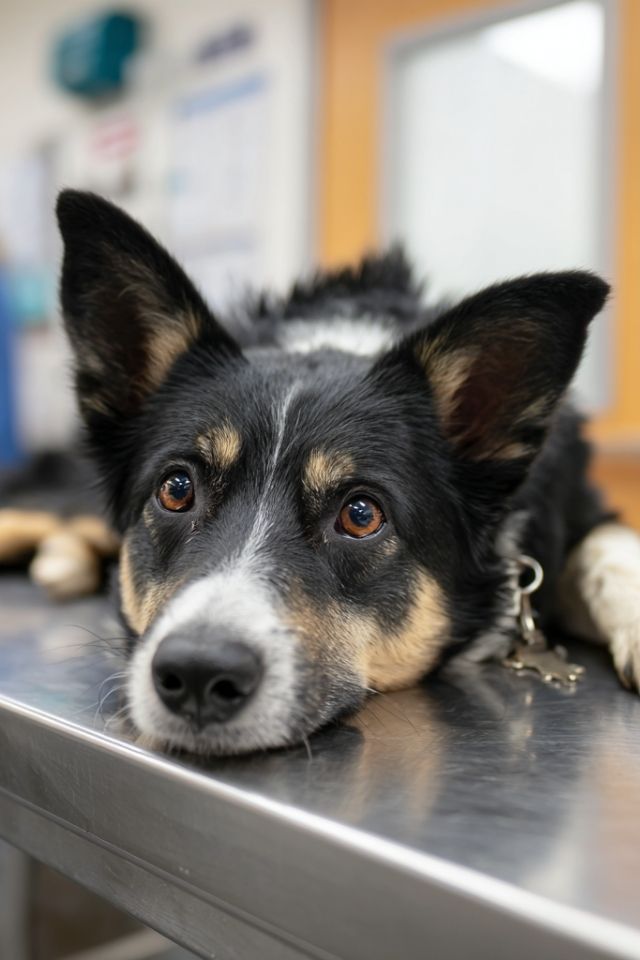The Long Road Home
There’s a moment on every long trail when you feel it—that subtle shift in your dog’s gait, the way their breath finds rhythm with the wind, how their eyes soften into something ancient and knowing. You’re watching thousands of years of evolution speak through muscle and sinew, breath and bone. This isn’t just exercise. This is your dog remembering what it means to move with purpose across distance, to carry energy like a precious flame that must burn steady, not bright and brief.
I’ve stood at the edge of countless trails with handlers who ask the same question in different words: “How do I keep this fire burning?” They’re not just asking about food. They’re asking about partnership. About how to honor the body that carries such willing spirit through miles of terrain, through heat and cold, through the thousand small decisions that turn a walk into a journey.
The answer lives in understanding something profound: your dog’s body is not a machine that simply needs fuel. It’s a living laboratory of metabolic intelligence, capable of reading its own needs, shifting between energy sources like a river finding its path around stone. Fat becomes flame. Carbohydrate transforms into quick power. Protein rebuilds what effort tears down. And somewhere in this alchemy of metabolism, if you’re paying attention, you’ll find the key to endurance that doesn’t deplete—it deepens.
Let me show you what I’ve learned from watching sled dogs lean into harnesses at forty below, from Border Collies who herd with the intensity of prayer, from every athletic soul who’s taught me that feeding isn’t just about the bowl. It’s about the bond. 🧡
The Two Flames: Understanding Your Dog’s Inner Fire
Picture your dog’s muscles as a hearth that can burn two different fuels. One is fat—slow, steady, the kind of heat that sustains through long winter nights. The other is carbohydrate—quick to ignite, bright and powerful, the spark that catches when intensity demands it.
Most mornings, during easy movement, your dog’s body prefers the slow burn. Fat oxidizes quietly, efficiently, asking nothing but steady breath and patient time. But call for speed, demand a hillside sprint, and watch the metabolic switch flip. Now carbohydrate floods the system, glucose feeding muscle fibers that contract with explosive purpose.
Here’s where it gets beautiful, and unexpected: those legendary Alaskan sled dogs, bred and fed for generations on diets rich as winter salmon, reveal a secret. Despite their high-fat nutrition, their bodies don’t cling to fat metabolism during the hardest miles. Instead, as hours stretch into a day’s work, they become increasingly hungry for glucose. Their insulin sensitivity sharpens. Their cells open wider to carbohydrate. The metabolic strategy shifts from what’s stored in muscle to what flows in blood—a flexibility so elegant it postpones the moment when fatigue finally finds them.
This is the NeuroBond between nutrition and performance: your dog’s body knows things you haven’t yet asked. It reads intensity, duration, depletion. It chooses fuel sources with an intelligence that predates language. Your task isn’t to override this wisdom—it’s to support it.
When Fat Becomes Philosophy
There are handlers who’ve discovered something almost mystical about ketogenic feeding—that state where fat composes nearly three-quarters of every meal, where the body learns to burn what once would have been stored. In research laboratories, animals fed this way ran longer before exhaustion found them. Their muscles learned to speak the language of ketone bodies, those elegant molecules that fat becomes when carbohydrate grows scarce.
The transformation happens in the mitochondria—those tiny powerhouses inside every cell—where enzymes multiply and fat oxidation becomes not just possible but preferred. It’s metabolic education, the body learning a second fluency.
But here’s the nuance that matters: this gift of fat adaptation serves best during steady, patient work. The long trail. The moderate pace sustained for hours. When you ask for maximum intensity—the all-out sprint, the explosive burst—carbohydrate remains king. Even the most fat-adapted athlete feels the limits when glycogen runs dry and the finish line demands everything.
The Art of Feeding Forward: Before the Journey Begins
I remember watching a musher prepare breakfast for her team before a fifty-mile training run. It wasn’t elaborate—simple, digestible, timed precisely three hours before harness time. “I’m not feeding their stomach,” she told me, stirring the mixture with practiced hands. “I’m feeding what happens four hours from now, mile thirty, when they’ll need to remember they have more to give.”
This is the wisdom of pre-exercise nutrition: you’re feeding forward in time, priming metabolic pathways for demands that haven’t yet arrived.
The meal she prepared followed principles written in physiology:
- Light enough to digest completely before work began
- Rich in carbohydrates that would drip-feed glucose into bloodstream
- Free of the fiber and fat that sit heavy, that ask the gut to work when muscles need the blood
She’d learned, through seasons of trial and attention, that certain foods betray you mid-trail. High fiber ferments and cramps. Excessive fat delays gastric emptying, leaving dogs feeling full but unfueled. Protein, while essential for recovery, offers little advantage in the hours before effort.
But feed digestible carbohydrate at the right distance from work, and you’re setting the stage: glucose available but not spiking insulin, energy present but not demanding immediate use. The body waits, poised, ready.
The Invisible Leash of awareness teaches you to feel this timing—not just by clock, but by your dog’s signals. The way they move toward the door with light anticipation rather than sluggish fullness. The brightness in their eyes that says energy waits accessible, ready to become motion.
The Recovery Window: When Healing Meets Hunger
There’s a window after exertion when your dog’s body speaks a language of urgency most handlers miss. It’s not the obvious panting, not the immediate thirst—it’s quieter. At the cellular level, muscles are asking a question: “Will you help us rebuild, or leave us depleted?”
The first thirty minutes after sustained work are golden. Carbohydrates offered now don’t just satisfy hunger—they trigger a cascade of restoration. Glucose floods depleted glycogen stores at rates you won’t see again until tomorrow. Studies on working sled dogs have shown this clearly: immediate post-exercise carbohydrate supplementation doesn’t just replenish—it accelerates. Muscle glycogen repletion in those first four hours happens at rates that drop dramatically if you wait, if you delay, if you think “they can eat at dinner.”
For dogs running multiple heats in a day, competing across consecutive weekends, this window isn’t optional—it’s the difference between performance that sustains and bodies that slowly hollow out.
But carbohydrate alone tells an incomplete story. Add protein to this recovery meal—whey is particularly elegant here—and something additional happens. Liver glycogen replenishment accelerates beyond carbohydrate alone. Amino acids flood circulation, ready to repair what effort fractured at the microscopic level. The body reads this combined signal as permission: not just to restore, but to adapt. To become slightly more capable tomorrow than it was today.
The Omega-3 Story: Quieting the Inflammation
Somewhere in the hours after hard work, inflammation begins its conversation. It’s not entirely unwelcome—some inflammation signals adaptation, growth, positive change. But excessive oxidative stress, unchecked inflammatory cascades—these become the chronic whisper that erodes performance over seasons, that ages the athlete before their time.
This is where omega-3 fatty acids enter not as fuel but as medicine. These molecules—EPA and DHA drawn from cold ocean waters—reshape the inflammatory response. They shift the ratio of pro- and anti-inflammatory signals. They improve how mitochondria function under stress. They reduce muscle damage markers and speed the return to baseline.
I think of omega-3s as the nutrient equivalent of Soul Recall—that capacity to remember wholeness, to return to centered function even after disruption. Approximately 50 to 100 milligrams per kilogram of body weight daily, split between meals, becomes not supplementation but essential strategy for any dog whose work demands recovery measured in hours, not days. 🧠
The Training Effect: Teaching the Body to Burn Differently
Watch an untrained dog and a conditioned athlete run the same trail at the same pace. Outwardly, the effort looks similar. But inside, at the metabolic level, two completely different stories unfold.
The untrained dog burns through precious glycogen quickly, breathing hard, heart racing to supply oxygen to muscles that haven’t learned efficiency. The athlete beside them—months into consistent endurance training—moves with a different economy. Their muscles have learned to prefer fat oxidation, to spare glycogen for moments when intensity demands it. Mitochondria have multiplied inside muscle cells. Enzymes that break down fatty acids have increased their expression. The metabolic machinery has fundamentally reorganized itself around endurance.
This transformation doesn’t happen in a week. It’s the gift of patient, consistent training at moderate intensities—that zone around 60 to 75 percent of maximum heart rate where the body has time to adapt rather than just survive. Month by month, the muscle fibers themselves change character, becoming more oxidative, more fatigue-resistant.
But here’s what many miss: diet can support or sabotage this adaptation. Restrict dietary fat while trying to train fat oxidation, and you’re partially suppressing the very enzymes you’re trying to upregulate. The body needs substrate to learn substrate utilization. You can’t teach your dog’s metabolism to prefer fat burning while feeding a fat-restricted diet.
This is the dance between training stimulus and nutritional support—each amplifying the other, or when misaligned, each limiting what the other could achieve.
Reading the Elements: Feeding for Heat and Cold
I’ve watched working dogs in environments so different they might as well be different planets. Sled dogs at forty below, where every calorie becomes warmth before it becomes motion. Search dogs working desert mountains in July, where metabolic heat becomes the enemy and thermoregulation demands its own energy cost.
Temperature isn’t just environmental backdrop—it’s metabolic context.
In cold, caloric needs spike upward—sometimes 10 to 30 percent beyond temperate baseline, depending on how hard the mercury falls. Here, fat’s caloric density becomes blessing. Every gram provides more than twice the energy of carbohydrate or protein, reducing the sheer volume of food needed to sustain body temperature and work output. The dogs eat less bulk but carry more fuel. Their bodies become furnaces burning rich.
But in heat, the calculation shifts. Fat metabolism, for all its efficiency, produces less metabolic heat per unit of work than carbohydrate oxidation. There’s a theoretical elegance to this: feed higher fat ratios in hot conditions, and you’re marginally reducing the internal heat load your dog must dissipate through panting. Every small advantage matters when ambient temperature approaches body temperature and heat dissipation becomes the limiting factor in performance.
The handlers I’ve known who truly excel in extreme conditions don’t just adjust food—they read their dogs with the sensitivity the Invisible Leash demands. They notice the subtle shift in panting pattern that says “I’m managing” versus “I’m struggling.” They offer water proactively, not reactively. They understand that hydration isn’t separate from nutrition—it’s the medium through which every metabolic process flows.
The Daily Rhythm: When and What and Why
There’s a musicality to feeding athletic dogs well—not just what goes in the bowl, but when, in what combination, in what quantity relative to what’s coming.
On ordinary training days, the rhythm flows simply: smaller morning meal two to three hours before activity, leaving the digestive system light and available. Then evening, after work completes, the larger meal—60 to 70 percent of daily intake—when the body can focus entirely on digestion, restoration, the slow work of rebuilding.
But on competition days, everything tightens. The pre-exercise meal shifts earlier—three to four hours before start time—and becomes lighter still. Just enough carbohydrate to ensure glycogen stores sit full, not so much that digestion competes with performance. Then immediately after, within those precious thirty minutes, a small carbohydrate-rich snack. Not a meal—just the signal: “Begin restoration.” Two to three hours later, when breathing has calmed and heart rate returned to near-baseline, the full recovery meal arrives: balanced macronutrients, complete nutrition, permission to heal.
And on rest days—those often-neglected spaces between effort—calories drop 15 to 25 percent because energy expenditure has dropped. But protein intake remains steady because tissue repair doesn’t stop just because training did. This is discipline: adjusting food to match reality rather than habit.
The Mistakes That Speak Volumes
I’ve seen the same errors repeated across decades, across breeds, across handlers who should know better. They’re worth naming because recognition prevents repetition.
Overfeeding during low activity is perhaps the most common. Competition season ends, training volume drops, but the food bowl remains full. Slowly, invisibly, conditioning degrades beneath accumulating pounds. When the next season arrives, you’re asking that extra weight to move, to be carried, to not matter. But it always matters.
Neglecting the recovery window is the opposite error—underfeeding when the body most needs support. Handlers who optimize every detail before performance but then delay the post-exercise meal by hours, thinking “they can wait until dinner.” They can wait. But their adaptation can’t.
And competition experimentation—trying new foods during the most important performances—betrays such fundamental misunderstanding that it breaks my heart. The week of the big trial is not the moment to discover your dog doesn’t tolerate beef, or that higher fat content causes loose stool, or that a different feeding schedule disrupts sleep patterns. Competition demands the familiar, the proven, the utterly reliable.
These mistakes aren’t failures of knowledge—they’re failures of Soul Recall, that capacity to remember what we’ve learned through experience and let it guide present choices.
The Watching: How Your Dog Tells the Truth
Numbers matter—body weight, body condition score, calories calculated and macronutrients balanced. But the real feedback arrives through observation so careful it becomes meditation.
Watch how your dog finishes a long trail. Do they maintain pace through the final mile, or fade progressively? Strong finishing capacity suggests adequate fueling. Fading suggests glycogen depletion or insufficient caloric intake somewhere in the training-feeding equation.
Notice recovery time. The athlete who bounces back to normal behavior within two to three hours after sustained work is well-fueled, well-adapted. The dog who remains subdued for 24 hours is telling you something fundamental needs adjustment.
Read coat quality, stool consistency, enthusiasm for training. These aren’t separate from nutrition—they’re nutrition speaking through the body’s condition, saying either “this works” or “something’s missing.”
This is where the NeuroBond between you and your dog transcends protocol and becomes art. You develop sensitivity to micro-signals—the slight hesitation before jumping into the vehicle after a long hike, the extra seconds to rise from a down-stay, the subtle flatness in eyes that usually shine with anticipation. These whispers arrive before the shouts. Listen to them.
Coming Home: Where Science Meets Soul
We’ve walked through metabolism and macronutrients, through feeding windows and recovery protocols, through the biochemistry that underlies every sustained stride your dog takes across distance. But if I’ve learned anything watching athletic dogs and their handlers across years and miles, it’s this: the numbers only matter when they serve the relationship.
You can calculate optimal fat-to-carbohydrate ratios with precision. You can time pre-exercise meals to the minute. You can supplement omega-3s at research-supported dosages. All of this matters. All of it helps.
But what transforms good nutrition into great partnership is the moment you stop treating feeding as formula and start experiencing it as conversation. When you notice your dog moves with different energy on different macronutrient balances. When you feel the difference between adequate recovery and true restoration. When you read the subtle dimming that says “I need more carbohydrate on these long trail days” before performance drops.
This is the essence of Zoeta Dogsoul endurance nutrition: science providing the map, relationship providing the compass, and both working together to support not just performance but the joy that makes performance meaningful.
Your action isn’t to follow rules rigidly—it’s to understand principles deeply enough that you can adjust them to the individual dog standing before you, in this season, in these conditions, at this stage of their athletic life. To feed not just the body but the whole being. To support not just the miles covered but the partnership that makes those miles worth covering together.
When you watch your dog move with power and grace through sustained effort, recovering quickly, eagerly anticipating the next adventure—you’re witnessing nutrition aligned with nature. And in that alignment, performance and partnership become indistinguishable, two aspects of the same living truth. 🧡
That balance between precision and presence, between metabolic optimization and emotional attunement—that’s where endurance truly lives.






